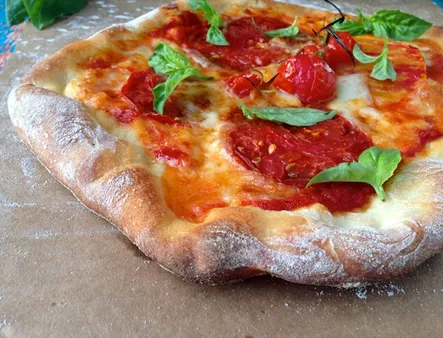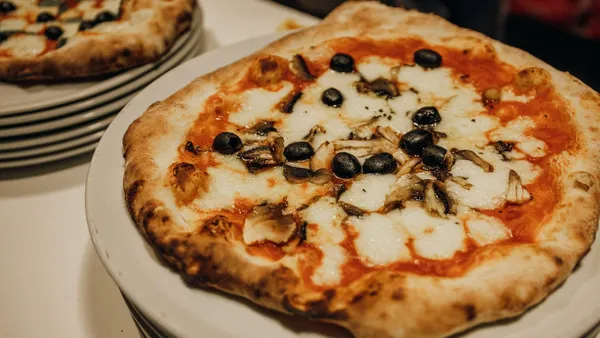Table of Contents
Welcome to Tauhuichiban, your culinary haven for all things Italian pizza. In this comprehensive guide, we'll embark on a delicious journey to teach you How to make authentic Italian pizza at home. From selecting the finest ingredients to perfecting the art of baking, we'll share our secrets and ise to ensure your pizza-making endeavors are nothing short of extraordinary. So, gather your ingredients, crank up your oven, and get ready to create a pizza that will transport your taste buds to the heart of Italy.

How to Make Authentic Italian Pizza: A Comprehensive Guide for Pizza Perfection
I. Creating the perfect dough
Achieving the Right Consistency
The ideal dough for authentic Italian pizza is elastic and pliable, providing the perfect balance of firmness and stretchiness. To achieve this, strong bread flour is essential, as its high protein content forms a robust gluten network. The amount of water used will determine the dough's hydration level, with a higher hydration yielding a crispier crust and a more pliable interior. By carefully measuring the flour and water ratio, you'll create a dough that handles beautifully and results in an exceptional pizza.
Once you've measured out the ingredients, combine them in a large bowl and use a wooden spoon to mix until a shaggy dough forms. Turn the dough out onto a lightly floured surface and begin kneading. Use the heel of your hand to push and fold the dough, working it until it becomes smooth and elastic. This process develops the gluten network, giving the dough its strength and structure.
Controlling Fermentation
After the dough has been kneaded, it's time to let it rest and ferment. This allows the yeast to convert the sugars in the flour into carbon dioxide, creating the bubbles that will give your pizza its characteristic lightness and airy texture. The fermentation process is influenced by time and temperature, with a longer fermentation at a cooler temperature yielding a more flavorful and complex dough.
Fermentation Temperature | Fermentation Time | Characteristics |
|---|---|---|
Room temperature (70-75°F) | 12-24 hours | Quick fermentation, resulting in a mild flavor and a slightly chewier texture |
Refrigerator (35-40°F) | 2-3 days | Slow fermentation, developing a more complex flavor and a crisp, airy crust |
Combination of room temperature and refrigerator | 1 hour at room temperature, then refrigerated overnight | Hybrid approach, balancing flavor development and convenience |
During the fermentation process, the dough should be folded or stretched every few hours to redistribute the yeast and promote even fermentation. This technique also helps develop the dough's strength and elasticity.

Creating the perfect dough
II. Preparing and adding toppings
Choosing the right toppings
When choosing toppings for your pizza, there are a few things to keep in mind. First, consider the flavors of the sauce and cheese. You want to choose toppings that will complement these flavors, not overpower them. For example, if you're using a tomato sauce, you might want to choose toppings like pepperoni, sausage, or mushrooms. If you're using a white sauce, you might want to choose toppings like artichoke hearts, spinach, or ricotta cheese.Second, consider the textures of the toppings. You want to choose toppings that will add a variety of textures to your pizza. For example, you might want to include some crunchy toppings, like croutons or bacon, and some soft toppings, like mozzarella cheese or mushrooms.Finally, consider the colors of the toppings. You want to choose toppings that will create a visually appealing pizza. For example, you might want to include some green toppings, like spinach or basil, and some red toppings, like tomatoes or pepperoni.
Adding the toppings
Once you've chosen your toppings, it's time to add them to the pizza. Start by spreading a thin layer of sauce over the crust. Then, add the cheese. Finally, add the toppings.When adding the toppings, be sure to distribute them evenly over the pizza. You don't want any one area of the pizza to be overloaded with toppings.Once you've added the toppings, bake the pizza according to the recipe instructions.
Topping | Flavor | Texture | Color |
|---|---|---|---|
Pepperoni | Salty, spicy | Crunchy | Red |
Sausage | Savory, meaty | Soft | Brown |
Mushrooms | Earthy, umami | Soft | White |
Artichoke hearts | Salty, tangy | Soft | Green |
Spinach | Mild, leafy | Soft | Green |
Ricotta cheese | Mild, creamy | Soft | White |
Croutons | Crunchy, buttery | Crunchy | Golden brown |
Bacon | Salty, smoky | Crunchy | Brown |
Basil | Fresh, herbaceous | Soft | Green |
Tomatoes | Sweet, tangy | Soft | Red |

Preparing and adding toppings
III. Baking the pizza to perfection
The art of baking pizza
Once your pizza is assembled, it's time to bake it to perfection. This is a crucial step, as it will determine the texture and flavor of your pizza. Here are a few tips for baking the perfect pizza:
1. Preheat your oven to the highest temperature it will go, usually around 500 degrees Fahrenheit. This will help to create a crispy crust.
2. Place your pizza on a preheated pizza stone or baking sheet. This will help to evenly distribute the heat and prevent the pizza from sticking.
3. Bake the pizza for 10-12 minutes, or until the crust is golden brown and the cheese is melted and bubbly.
4. Remove the pizza from the oven and let it cool for a few minutes before slicing and serving.
Troubleshooting common pizza baking problems
If you're having trouble getting your pizza to bake evenly, here are a few troubleshooting tips:
- Make sure your oven is preheated to the correct temperature.
- Use a pizza stone or baking sheet to evenly distribute the heat.
- Don't overcrowd the oven. If you're baking multiple pizzas, make sure to space them out so that they have room to cook evenly.
- If the crust is getting too dark, reduce the oven temperature or move the pizza to a lower rack.
- If the cheese is not melting evenly, increase the oven temperature or bake the pizza for a few minutes longer.
With a little practice, you'll be able to bake the perfect pizza every time.

Baking the pizza to perfection
IV. Enjoying your delicious creation
Once you've mastered the art of making authentic Italian pizza, it's time to savor the fruits of your labor. Gather your loved ones around the table and enjoy the delicious creation you've made together. The aroma of freshly baked pizza, the melted cheese, and the flavorful toppings will create a warm and inviting atmosphere. As you indulge in each slice, take a moment to appreciate the culinary journey you've been on. From selecting the finest ingredients to perfecting the techniques, you've put your heart and soul into this dish. Savor every bite and let the flavors dance on your palate. Remember, the best part of cooking is sharing it with those you care about. So, sit back, relax, and enjoy the fruits of your labor.
Related Posts |
|---|

Enjoying your delicious creation
V. Conclusion
Congratulations on mastering the art of authentic Italian pizza! With patience, practice, and the knowledge you've gained from this guide, you can consistently create delicious and impressive pizzas that will delight your family and friends. Remember, the key to success lies in using high-quality ingredients, following the steps carefully, and experimenting with different flavors to find your perfect combination. So, fire up your oven, gather your loved ones, and enjoy the fruits of your culinary adventure. Buon appetito!